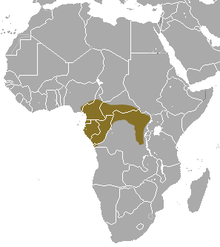Superregnum: Eukaryota
Cladus: Unikonta
Cladus: Opisthokonta
Cladus: Holozoa
Regnum: Animalia
Subregnum: Eumetazoa
Cladus: Bilateria
Cladus: Nephrozoa
Superphylum: Deuterostomia
Phylum: Chordata
Subphylum: Vertebrata
Infraphylum: Gnathostomata
Megaclassis: Osteichthyes
Cladus: Sarcopterygii
Cladus: Rhipidistia
Cladus: Tetrapodomorpha
Cladus: Eotetrapodiformes
Cladus: Elpistostegalia
Superclassis: Tetrapoda
Cladus: Reptiliomorpha
Cladus: Amniota
Cladus: Synapsida
Cladus: Eupelycosauria
Cladus: Sphenacodontia
Cladus: Sphenacodontoidea
Cladus: Therapsida
Cladus: Theriodontia
Subordo: Cynodontia
Infraordo: Eucynodontia
Cladus: Probainognathia
Cladus: Prozostrodontia
Cladus: Mammaliaformes
Classis: Mammalia
Subclassis: Trechnotheria
Infraclassis: Zatheria
Supercohors: Theria
Cohors: Eutheria
Infraclassis: Placentalia
Cladus: Boreoeutheria
Superordo: Laurasiatheria
Cladus: Ferae
Ordo: Carnivora
Subordo: Feliformia
Familia: Herpestidae
Subfamilia: Herpestinae
Genus: Bdeogale
Species: B. crassicauda - B. jacksoni - B. nigripes
Name
Bdeogale (Peters, 1850)
References
Bdeogale in Mammal Species of the World.
Wilson, Don E. & Reeder, DeeAnn M. (Editors) 2005. Mammal Species of the World – A Taxonomic and Geographic Reference. Third edition. ISBN 0-8018-8221-4.
Bdeogale is a mongoose genus that was proposed by Wilhelm Peters in 1850 based on a mongoose specimen collected in Mozambique.[1] Bdeogale species have compact paws with four symmetrical toes, round ears and a blunt muzzle with a broad round and bare rhinarium. The genus contains four species that are primarily terrestrial and omnivorous and forage in dense vegetation.[2]
Species
| Name | Distribution and IUCN Red List status |
|---|---|
| Bushy-tailed mongoose (B. crassicauda) Peters, 1852[3]
|
Kenya and Tanzania LC[4]
|
| Black-footed mongoose (B. nigripes) Pucheran, 1855[5] |  LC[6] |
| Jackson's mongoose (B. jacksoni) (Thomas, 1894)[7] |  NT[8] |
| Sokoke dog mongoose (B. omnivora) Heller, 1914[9] | Kenya and Tanzania VU[10] |
References
Peters, W. (1850). "Bdeogale". Sitzungsberichte der Gesellschaft Naturforschender Freunde zu Berlin: 94.
Kingdon, J. (2015). "Bdeogale". The Kingdon Field Guide to African Mammals (Second ed.). London, New Delhi, New York, Sydney: Bloomsbury Publishing. p. 441. ISBN 9781472925312.
Peters, W. (1852). "Mittheilung über die in Mossambique beobachteten Mangusten". Verhandlungen der Königlich Preussischen Akademie der Wissenschaften zu Berlin: 81–82.
White, P.A.; Fischer, C.; Hausser, Y.; Foley, C. & Do Linh San, E. (2016). "Bdeogale crassicauda". IUCN Red List of Threatened Species. 2016: e.T41591A97163568.
Pucheran, J.P. (1855). "Les Mammifères de la côte occidental d'Afrique". Revue et magasin de zoologie pure et appliquée. 2. 7: 111.
Angelici, F. M. & Do Linh San, E. (2015). "Bdeogale nigripes". IUCN Red List of Threatened Species. 2015: e.T41592A45205243.
Thomas, O. (1894). "On a new African Genus of Mustelidae". The Annals and Magazine of Natural History; Zoology, Botany, and Geology. 6. 13 (78): 522–524.
De Luca, W.; Rovero, F. & Do Linh San, E. (2015). "Bdeogale jacksoni". IUCN Red List of Threatened Species. 2015: e.T2675A45196818.
Heller, E. (1914). "New antelopes and carnivores from British East Africa". Smithsonian Miscellaneous Collections. 61 (2240): 1–15.
Foley, C. & Do Linh San, E. (2016). "Bdeogale omnivora". IUCN Red List of Threatened Species. 2016: e.T136686A45221619.
Retrieved from "http://en.wikipedia.org/"
All text is available under the terms of the GNU Free Documentation License



